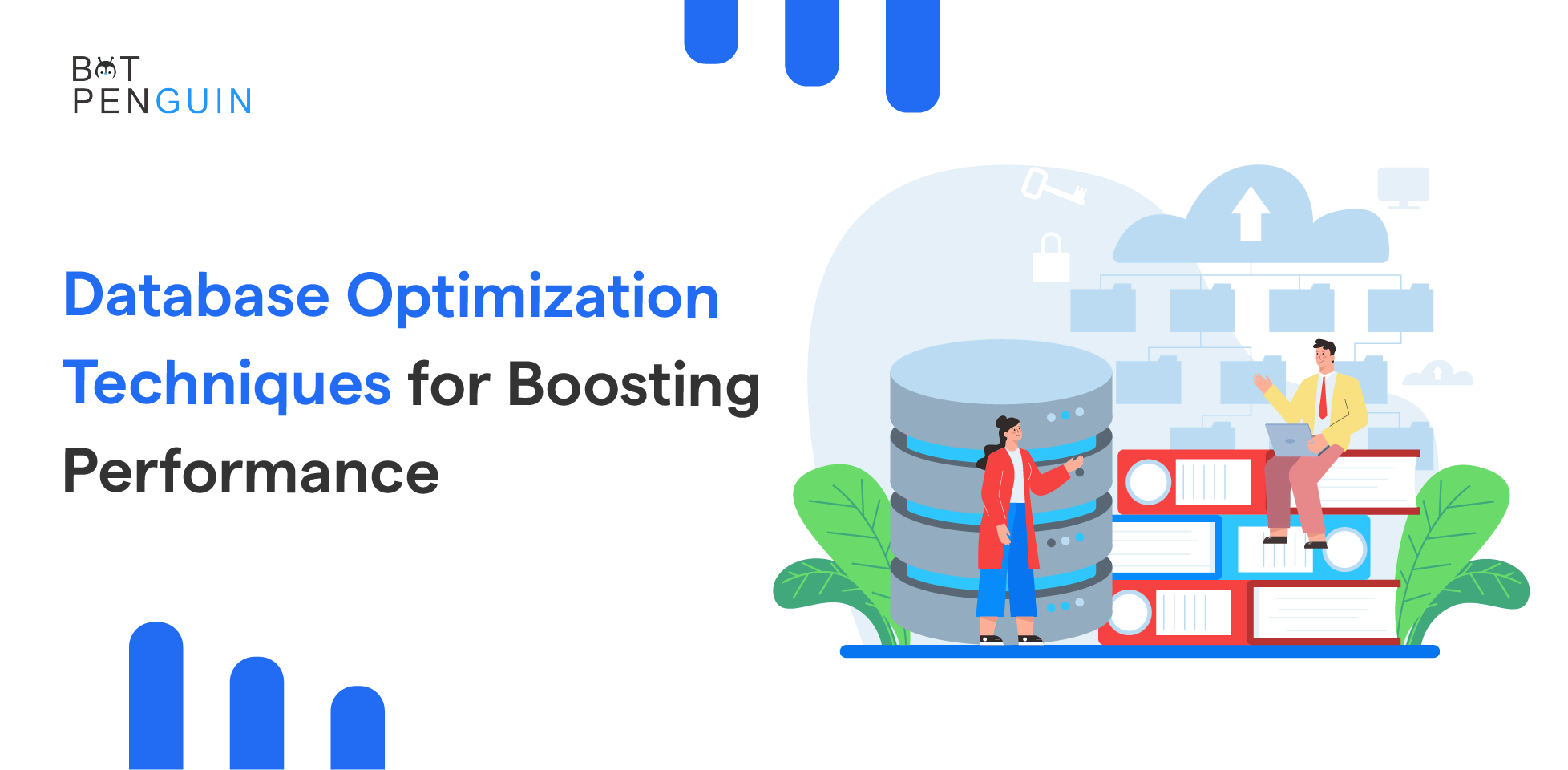According to Akamaiid, a one-second delay in page load time can result in a 7% reduction in conversions.
Database optimization has become essential for web developers to improve the performance of web applications and, as a result, the user experience. Some may find it unattractive, yet the advantages outweigh the effort.
When optimizing your database effectively, you will boost performance, remove bottlenecks, and save resources.
Fortunately, some optimization strategies do not necessitate DBA-level (database administrator) SQL-query expertise.
Let’s start with the 10 best techniques for web developers to optimize your database.
Once you finish the basics, you may get deeper into database optimization.
What is Database Optimization?
Database optimization is like giving your database a turbo boost! It's all about fine-tuning and optimizing your database to achieve lightning-fast performance and ensure a seamless user experience.
It organizes and arranges your database to maximize efficiency and reduce response time.
The goal is to make your database lightning quick, capable of handling massive amounts of data and providing results in a flash.
Database optimization leads to increased performance. Your users will appreciate lightning-fast response times and frictionless interactions.
Database optimization reduces server load, increases scalability, and improves data integrity.
Step-by-Step Guide: How to Optimize a Database
A step-by-step guide to help you optimize your database like a pro.
- Identify Performance Issues
Begin by analyzing the database's current performance. Identify slow queries, bottlenecks, and areas that require improvement.
- Set Performance Goals
Define clear performance goals based on the specific needs of your application. Determine metrics like response time, throughput, and concurrent user capacity.
- Profile Queries
Use database profiling tools to analyze query execution plans and identify queries that consume excessive resources. Understand which queries need optimization.
- Optimize Queries
Refactor and optimize queries using techniques like proper indexing, avoiding unnecessary JOINs, and using efficient WHERE clauses.
- Normalize and Denormalize
Evaluate your database's schema for normalization opportunities to eliminate redundancy. In some cases, consider denormalization for improved read performance.
- Indexing Strategy
Choose appropriate indexing strategies for frequently queried columns. Ensure indexes are not overused, as they can impact write performance.
- Consider Caching
Implement caching mechanisms (like in-memory databases or query result caching) for frequently accessed data to reduce the load on the main database.
- Partitioning
Consider partitioning data into smaller chunks for large tables based on specific criteria. This enhances query performance and simplifies maintenance.
- Regular Maintenance
Schedule regular maintenance tasks such as updating statistics, rebuilding indexes, and removing obsolete data to keep the database performing optimally.
- Hardware and Configuration
Optimize the database server's hardware settings and configuration parameters to align with your workload and requirements.
- Monitor and Analyze
Continuously monitor the database's performance using monitoring tools. Collect and analyze performance data to identify trends and potential issues.
- Load Testing
Conduct load testing to simulate real-world usage and identify the database's performance under various traffic levels. Adjust configurations based on test results.
- Backup and Recovery Testing
Regularly test backup and recovery processes to ensure data integrity and prepare for unforeseen issues.
- Documentation
Document all optimizations, configurations, and changes made to the database. This documentation helps maintain the database's optimal state over time.
Suggested Reading:
10 Database Optimization Techniques for Boosting Performance
Are you ready to take your database performance to the next level?
Let’s learn 10 powerful techniques to supercharge your database and leave your competitors in the dust.
Get ready to optimize like a pro!
1. Indexing Strategies for Improved Performance
Indexing is like creating a roadmap for your database. It helps the database engine find the needed data, resulting in faster query execution.
2. Query Optimization Techniques
Queries are the heart and soul of any database application.
Optimizing your queries can have a significant impact on performance.
3. Data Normalization and Denormalization
Data normalization is about organizing data to minimize redundancy and improve data integrity. On the other hand, denormalization involves strategically introducing redundancy to optimize query performance.
4. Partitioning and Sharding
As your database grows, partitioning and sharding can help distribute the data across multiple servers, improving scalability and performance.
5. Caching Strategies for Database Optimization
Caching is like having a super-fast memory for your frequently accessed data.
By caching query results or even entire database objects, you can dramatically reduce the load on your database and improve response times.
6. Database Performance Monitoring and Tuning
To optimize your database, you need to understand its performance characteristics. Explore various monitoring tools and techniques to track database performance metrics.
7. Database Maintenance and Housekeeping
Like a well-maintained car, your database needs regular maintenance to run smoothly. Regularly perform tasks like updating statistics, rebuilding indexes, and cleaning up outdated records to maintain optimal performance.
8. Scaling and Load Balancing
As your user base grows, scaling your database becomes crucial.
Horizontal and vertical scaling techniques to handle increased traffic and ensure optimal performance.
9. Security Considerations in Database Optimization
Database optimization and security go hand in hand.
Best practices for securing your database include user authentication, role-based access control, and encryption. We'll also explore the balance between security measures and performance optimization.
10. Database Compression Techniques
Database compression can significantly reduce storage requirements and improve I/O performance. Apply data compression techniques to reduce storage requirements, improving I/O performance and decreasing data retrieval times.
Top Tools for Database Optimization: Simplifying the Process
Several popular tools are widely used for database optimization, helping to enhance database performance, efficiency, and overall reliability.
Let’s explore some popular tools that have gained recognition in the database optimization space.
- SQL Server Management Studio (SSMS)
SSMS is a comprehensive tool Microsoft provides for managing and optimizing SQL Server databases.
It offers many features, including query optimization, performance monitoring, and database tuning advisor.
- MySQL Workbench
With MySQL Workbench, you can analyze query performance, optimize SQL statements, and monitor database health.
It also offers features like schema synchronization and database migration.
- Oracle SQL Developer
Oracle SQL Developer provides database management tools for Oracle databases.
It includes features for query optimization, performance tuning, and visualizing execution plans.
- DBVisualizer
DBVisualizer is a universal database tool that supports various database management systems.
It offers query optimization, database monitoring, and performance analysis features.
- DBForge Studio
DBForge Studio is a comprehensive database development and management tool that supports various database systems.
It includes performance profiling, query optimization, and monitoring capabilities.
- Navicat
Navicat is a database management and administration tool that supports multiple databases.
It offers query optimization, performance monitoring, and management features.
- MongoDB Compass
MongoDB Compass is a graphical user interface for MongoDB databases.
It includes performance monitoring, query analysis, and optimization features for MongoDB users.
- Oracle Enterprise Manager
Oracle Enterprise Manager is a comprehensive tool for managing and optimizing Oracle databases.
It offers a centralized database administration, performance monitoring, and tuning platform.
With Oracle Enterprise Manager, you can analyze database performance metrics, identify bottlenecks, and optimize SQL statements. It also provides features like automated performance diagnostics and tuning advisors.
Conclusion
Database optimization is difficult, yet neglecting it entirely might significantly influence your online application, resulting in performance issues.
Following these 10 best database optimization practices for web developers, you'll be heading to better user experience and resource management.
It can significantly improve query performance, reduce response times, and provide a seamless user experience.
Remember to continuously monitor and fine-tune your database to adapt to changing needs and ensure optimal performance.
Now, it's time for you to put these techniques into action and unleash the full potential of your database. After you've implemented these methods, read on for further information on how to optimize database speed.
Experiment, measure, and iterate to find the best optimization strategies for your specific use case.
We hope this guide has given you the knowledge and tools to supercharge your database performance.
Frequently Asked Questions (FAQs)
What is database optimization?
Database optimization refers to improving a database system's performance, efficiency, and reliability.
Why is database optimization important?
Optimizing databases includes improved performance, faster response times, and enhanced user experience.
What are some common challenges in database optimization?
Analyzing database performance involves using tools and techniques to measure and evaluate the performance of a database.
How do indexing strategies improve database performance?
Identifying bottlenecks and performance issues helps pinpoint areas that need improvement, such as slow queries or inefficient database design.
What is query optimization, and how does it help?
Indexing is a technique that improves query performance by creating data structures that allow for faster data retrieval.
What are the benefits of using caching in database optimization?
Caching involves storing frequently accessed data in memory to reduce the need for repeated database queries. This leads to faster response times and decreased database load, ultimately improving overall performance.
How does database normalization contribute to optimization?
Database normalization is a design technique that minimizes data redundancy and ensures data integrity. It helps optimize storage and query performance by organizing data into efficient structures, reducing duplication and inconsistencies.
What role do database indexes play in optimization?
Indexes are data structures that improve the speed of data retrieval operations. Database systems can quickly locate the desired data by creating indexes on frequently used columns, significantly enhancing query performance.













